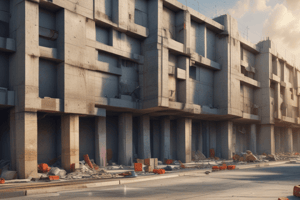Podcast
Questions and Answers
What is concrete made of?
What is concrete made of?
A mixture of sand, gravel, crushed rock, or other aggregates held together by a paste of cement and water.
What is the main purpose of reinforcing bars in reinforced concrete?
What is the main purpose of reinforcing bars in reinforced concrete?
To develop the tension forces needed for moment equilibrium after the concrete cracks.
Which of the following are advantages of reinforced concrete? (Select all that apply)
Which of the following are advantages of reinforced concrete? (Select all that apply)
- Rigidity (correct)
- Low Tensile Strength
- Economy (correct)
- Fire Resistance (correct)
Which of these is a disadvantage of reinforced concrete?
Which of these is a disadvantage of reinforced concrete?
What is the range of compressive strength for concrete?
What is the range of compressive strength for concrete?
What does the term 'shrinkage' refer to in the context of concrete?
What does the term 'shrinkage' refer to in the context of concrete?
What is creep in relation to concrete?
What is creep in relation to concrete?
What factors can affect the compressive strength of concrete?
What factors can affect the compressive strength of concrete?
Flashcards are hidden until you start studying
Study Notes
Concrete Basics
- Concrete is formed by mixing sand, gravel, crushed rock, or aggregates with a paste of cement and water to create a solid mass.
- It is commonly used in construction due to its durability and versatility.
Reinforced Concrete
- Incorporates reinforcing bars (rebar) to manage tension forces, crucial for maintaining moment equilibrium after cracking occurs.
- Design requires adherence to static laws and material mechanics to assure constructability, cost-effectiveness, and longevity.
Advantages of Reinforced Concrete
- Economical and effective for both structural integrity and architectural aesthetics.
- Offers fire resistance, enhancing safety during fires.
- Provides rigidity for improved structural performance.
- Low maintenance requirements reduce long-term costs.
- Materials are widely available, making reinforced concrete a common building choice.
Disadvantages of Reinforced Concrete
- Exhibits low tensile strength, necessitating the use of reinforcement.
- Requires forms and shoring to ensure structural stability during curing and setting.
- Has relatively low strength per unit weight/volume when compared to other materials.
- Experiences time-dependent volume changes, such as shrinkage, which can lead to structural concerns.
Properties of Concrete
- Compressive Strength: Ranges from 3000 to 20000 psi, indicating its ability to withstand axial loads.
- Modulus of Elasticity: Lacks a specific value, depending on various factors including concrete composition.
- Poisson's Ratio: Usually ranges from 0.11 to 0.21, with an average around 0.16; indicates the ratio of lateral strain to axial strain.
- Shrinkage: Refers to volume decrease during hardening and drying under constant temperature.
- Creep: Describes deformation under sustained load, impacting long-term structural integrity.
- Tensile Strength: Assessed by applying compressive load on a lateral cylinder, important for understanding failure modes.
- Shear Strength: Represents resistance to sliding forces, critical for structural stability.
Factors Affecting Compressive Strength
- Water/Cement Ratio: The relationship between the weight of water and cement affects the strength and durability of concrete.
- Type of Cement: Different cement types impart varying properties to the final concrete product.
- Supplementary Cementitious Materials: Addition of materials like fly ash or slag can enhance performance and sustainability.
Studying That Suits You
Use AI to generate personalized quizzes and flashcards to suit your learning preferences.




